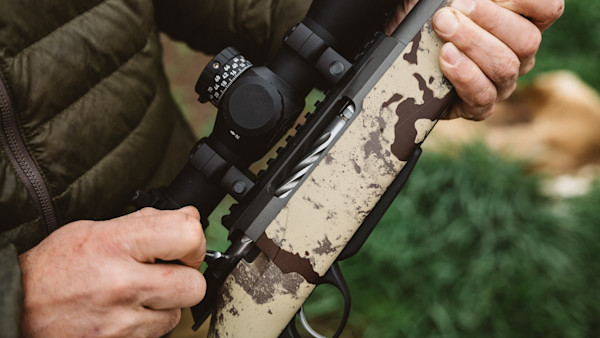
What am I doing with my life?
At the time, it seemed like a fair question. I’d been at the gun range two hours, but I’d only pulled the trigger eight times. I had been attempting to follow the barrel maker’s break-in procedure, and it wasn’t going well.
You may have seen similar instructions buried in the user’s manuals of your own rifles. Like new hiking boots or that t-shirt you will never (ever!) let your spouse throw away, new barrels need to be “broken in.” The specifics of this process vary, but it always involves cleaning a barrel every shot or two until patches indicate less copper fouling. This usually takes 8 to 12 shots. After that, the barrel should be cleaned every five shots until the same goal is met.
My existential crisis stemmed from the fact that this is an incredibly tedious process. While my fellow range-goers were ringing steel, I was dutifully, miserably cleaning my rifle. I’ve always wondered whether rifle barrels really need to be broken in, and that day, I decided to get some answers.
Why You Should Break In a Barrel
You might rightly be suspicious about advice on Internet forums or from the guy behind the gun counter, but many gun makers–such as Weatherby, Christensen Arms, and Lilja–recommend a break-in procedure.
The basic idea is that the shoot-clean-shoot-clean process smooths out whatever tiny tool marks are still present in the bore, and cleaning ensures that copper fouling doesn’t become forever stuck in those imperfections before they’re smoothed out.
Carson Lilja of Lilja Precision Rifle Barrels admitted that there is some debate about what happens during a barrel break-in process, but he believes it’s important.
“For the most part, the main thing you are breaking in is the throat,” he told me, referring to the area of a bore immediately in front of the chamber where a loaded bullet resides. “The rougher the finish in the throat, the more copper fouling and longer it takes to break in. Removing this copper fouling during break-in will prevent buildup that develops later on.”
Competitive shooter Bennie Coolie told me he breaks in his barrel by cleaning the barrel with a patch soaked in JB Bore Paste and wrapped on a nylon brush. He cleans after every shot for the first five shots and then does the same process every three shots for another 15 rounds. He then scrubs out the barrel until he gets wet patches coming out clean.
“My main focus during this is to ensure the chamber area is smoothed out. As you do this sequence, you will definitively feel the barrel smoothing out,” he said.
When I’ve worked through the break-in process in my own rifles, I can see it’s doing something. For the first few shots, the copper fouling is heavy (indicated by the blue color on the patches when using copper solvent), and it takes some serious scrubbing to get it out. But after five or ten shots, the copper fouling decreases as those small imperfections are smoothed out, and the copper has fewer places to adhere.
This, I think, is why shooters continue to break in their barrels and companies continue to advise it. Copper fouling is clearly diminishing, and copper fouling can degrade accuracy. It’s hard to disbelieve your own eyes.
Why You Don’t Need to Break In a Barrel
Ending the discussion there, however, misses the point. The break-in process isn’t just about reducing copper fouling. It’s about increasing accuracy.
It’s difficult to definitely prove this one way or the other (which I think is why this debate persists). You can’t break in a barrel, test its accuracy, and go back in time to test the accuracy of the same barrel without breaking it in. You can use two different barrels from the same company, but there’s no way to tell whether one of the barrels is just more accurate than the other–break-in process or not.
Still, Lilja says he believes a barrel that has been broken in does stand a better chance of being more accurate. While those accuracy gains might be minimal on the average PRS-style or hunting rifle, he’s seen significant gains on benchrest-style rifles.
Others are less sure. Another competitive shooter, Ckye Thomas of MDT, said, simply, “My barrel break-in consists of me shooting my gun.” He waits to do load development until he’s shot about 200 rounds, but he doesn’t do any special cleaning regime.
In my own experience, one of my most accurate rifles is one that I didn’t break in first. This rifle consistently shoots 0.5-inch groups with factory, non-match ammo, but it’s not a high-end rifle, so I didn’t bother breaking it in. You can imagine my delight when I realized my good fortune.
On the other hand, I’ve broken in excellent (read: expensive) rifles that didn’t end up being as accurate as that one. Would they have been even less accurate without having broken in the barrel? Maybe. But it’s clear that whatever the break-in process does, it may not be enough to turn a lemon into lemonade.
The Real Break-In Process
While the efficacy of the shoot-clean-shoot-clean process is debatable, no one can deny that rifles often need a breaking-in period before they reach peak accuracy and consistent velocities. A new barrel will often print disappointing groups until it's had a certain number of rounds down the barrel. That number changes from barrel to barrel, and constant cleaning isn't necessary for this kind of break-in to occur.
MeatEater’s Garrett Long described a process that takes a middle road between the tedious, clean-every-shot method and not doing anything at all.
“Break-in process for me is simply trying to get my speed and point of impact to settle in as quickly as possible,” he said. “I take a fire- and clean-heavy approach to get my rifle there as fast as possible–usually in 10- to 20-round increments.”
He’ll shoot a new rifle about 20 times, keeping careful track of the velocities. Then he cleans it “fairly aggressively” with Bore Tech Eliminator and repeats the process until he starts seeing consistent velocities.
“Once my speed stabilizes, I’ll set zero, and let that sucker roll. I’ve found that this method gets my barrel to a relatively stable state in about 80 rounds as opposed to 200,” he explained.
Bottom Line
If you’ve read this far and you’re still scratching your head, join the club. Much like the “how often should you clean your gun” debate, this conversation continues because even experts disagree. But based on all the conversations I’ve had about this topic, here’s the bottom line:
- Complicated and cleaning-heavy break-in procedures are unlikely to increase your gun’s accuracy in any measurable way.
- However, it’s important to remove copper fouling regularly on a new barrel. This may not need to be done every single round, but removing the copper while the throat is still smoothing out will make the barrel easier to clean down the road.
- Barrels do require a breaking-in period to achieve maximum accuracy and stable velocities. This is typically accomplished within 200 rounds (usually less), but does not require the shoot-clean-shoot-clean break-in method.
As far as I can tell, that may be as close to the truth as we’re going to get in this life. If you disagree, feel free to let me know in the comments.







Conversation